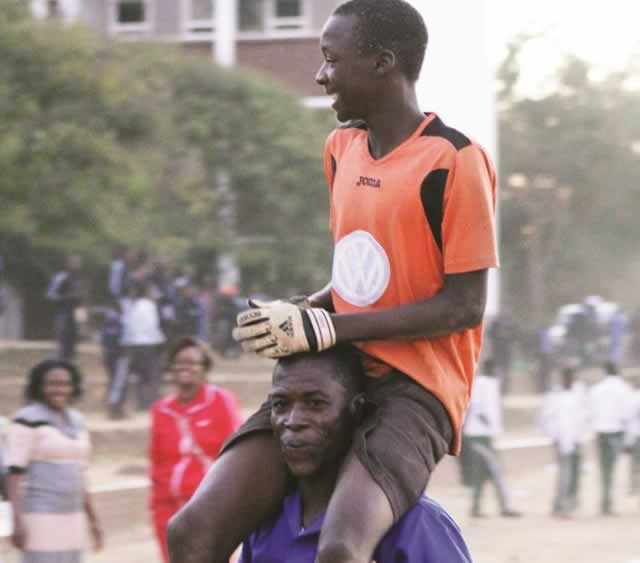The curse of the Rhodesians


The Regional, Town and Country Planning Act, which today, with very little modifications since 1996, is still the centrepiece of planning law in Zimbabwe
Baffour’s Beefs with Baffour Ankomah
MUNICIPAL and town councils should stop behaving like Rhodesians. This is Zimbabwe, not Southern Rhodesia.
Irina Bokova, the Director-General of UNESCO, and Leila Zerougui, Ban Ki-moon’s Special Representative for Children and Armed Conflict, have just been to Juba, capital of South Sudan, this week to talk about child soldiers and child labour, and how terrible the twin evils are.
As a fitting riposte, one of the country’s newspapers published a cartoon showing two babies in huge nappies debating the essence of life. One child, with his chin planted firmly in his left palm as thinking adults do, says to the other: “Rent, taxes, death; I hate growing up.” To which the other replies: “If child labour is a crime, why do teachers give homework?”
Sweet, isn’t it? And that baby had reason. To a child, work is work, whether done at home or outside it; and homework can sometimes be as frightening and tedious to a child as being asked to carry firewood home from the farm or to sell oranges by the roadside. Which is what many of us did when growing up. But not a bird sang that it was child labour.
Today, to a now sanctimonious West, a child selling oranges by the roadside is child labour. But not many scores of years ago, the West had no problem creating its wealth partly on child labour!
In Britain and elsewhere, they pushed children into the coal mines to work till they cried for their mothers. It is thus rich that today the same countries that used child labour are the ones championing laws banning child labour, and preaching sermons about how odious the practice is.
Yet, even today a 16-year-old child is still legally qualified to serve in the British and US armed forces. To them that is not child labour, nor could that “soldier” be described as a child soldier.
Interestingly, that same child in the army cannot vote until he is 18, meaning he is not an adult yet. So if you are not an adult, what are you? A child, no matter how big the gun you carry in your damned hands. But don’t tell Bokova and Zerougui. They might tell the Americans and you might get a visitation by drones.
An unjust law
Talking about law brings the memory of Martin Luther, standing alone in the cold winter of Germany and telling the popes of his day that “an unjust law is no law at all”.
Immanuel Kant even had a different take. “The touchstone of everything that can be concluded as a law for a people lies in the question whether the people could have imposed such a law on themselves,” he argued.
To which Wilhelm Reich, in his book, Listen, Little Man!, posits: “I observe to the letter all laws that make sense but combat those that are obsolete or absurd.”
In the land that was once part of the mighty Munhumutapa Empire, there is one such “obsolete and absurd” law – the Regional, Town and Country Planning Act Chapter 29:12 (RTCPA 29.12) that deserves to be passionately discussed and combatted, because it is not a law that the people of Zimbabwe could have imposed on themselves if the Rhodesians had not imposed it.
The wonder, therefore, is how the African, independent for 34 years, has allowed this “obsolete and absurd” law to continue to rule his life, to the point where even the new towns and suburbs he has built after independence still have the look and smell of the Rhodesians.
For those who don’t know, the RTCPA 29:12 is the core planning law in Zimbabwe. It has been highly criticised in the past for its rigidity, even though its Preamble ironically claims it is “an Act to provide for the planning of regions, districts and local areas with the object – [and here is the rub] – of conserving and improving the physical environment and in particular promoting health, safety, order, amenity, convenience and general welfare, as well as efficiency and economy in the process of development and the improvement of communications … and generally to regulate the appearance of the townscape and landscape.”
Please mind the word, object; and the phrases, improving the physical environment; and in particular promoting health, safety … convenience and general welfare”.
We should not even prolong the argument – can anybody, today, with his hand on his heart, sincerely say that the “locations” (or satellite towns) surrounding Zimbabwe’s cities have improved the physical environment? Has the clustering of homes and the cramped living spaces therein promoted health, safety, convenience and general welfare of the people?
Not fit for human life
When I first entered the home of an ordinary Zimbabwean 12 years ago, I was shocked by how little the space assigned to six people to live in. My host and his wife had four children, and their home in one of the “locations” (what an astonishing term!) surrounding Harare did not lack the basic things one would expect to see in an ordinary man’s home.
But boy, when the English coined the phrase, “not enough room to swing a cat”, they actually meant my host’s living room.
With a medium-sized centre-table dominating the middle of the room, and a twin-sofa on either side of the centre-table, my host, his wife and four children literally had to squeeze their way around the centre-table to get to the other side of the room.
The sight and size of that room depressed me to no end. And considering that I had lived in Britain for 16 years at the time, and UK living spaces are not generous either, I don’t know why the size of that room had such a despairing impact on me.
As my host drove me back to town from the “location” (how amazing that a real human being conjured that term, “location”, to describe African habitation in Zimbabwe, as against the “suburb” where whites lived), he sensed that I had become quiet and asked if everything was okay.
I told him I was okay, but he was not convinced. “Is it the look of the location that disturbed you?”, he asked. “Lo-what?”, I asked in astonishment. “The location, the area we live in; it was built by the Rhodesians for black people. That is why they made the rooms that small,” he said.
It was the first time I became acquainted with the term “location”. The Africans live in “locations”, the whites live in “suburbs”. And suburbs, if they are leafy like the Northern Suburbs of Harare, have a tinge of romanticism about them, don’t they?
Ethnic wives
“Location” in fact reminds me of another terminology in Zimbabwe, “ethnic”, which I hear sometimes from the mature lips of mature Africans to describe certain things God has given them.
Ethnic clothes, ethnic food, ethnic this, ethnic that. We should not be surprised to see fully developed ethnic wives and husbands on a merry walk to the shops one of these days.
When I first heard “ethnic” being used to describe African clothing, I marvelled at the depth of brainwashing that had gone on in Zimbabwe before independence. In the UK, “ethnic” is used to describe people like you and I and our community. To the natives of the British Isles, the non-natives are “ethnic”, not the other way round.
So how is it the other way round in Zimbabwe, where the white community is just 1 percent or less of the wider population? They are ethnic, not the Africans.
But surprise, surprise, the Africans here, zombie-like, accept that their clothes and ways are “ethnic”. Ethnic clothes in ethnic style in ethnic homes in ethnic locations, if not in ethnic heads! How could we accept such descriptions?
The Coloured areas
Since my first encounter with the “location” 12 years ago, I have come to understand that living spaces in the former Coloured areas are no better – maybe only slightly better than the African’s in the sense that the ex-Coloured areas have larger plots and more trees, and the general landscape or townscape is also better.
Comparing this with the “suburbs” that the white man built for the white man, you get the feeling that you are on a different planet. Which reinforces the view held by many discerning Africans that the man called Murungu or Muzungu or Obroni or Oyibo (depending on which part of Africa he landed from the sea), is a different kettle of fish.
Stripped down to his pants, this Murungu, despite all the bravado he exudes, suffers from what I call an insecurity complex – as against the inferiority complex that the colonial, and even the post-colonial, African suffers.
And it is this insecurity complex that makes the Murungu behave the way he does. If he allows the African or any “native” anywhere in the world to be at par with him, he doesn’t feel secure.
So he must have a “suburb” and the African a “location”. He must have the land and the African a rock. He must have all the big guns in the world, and other people bows and arrows.
It is a serious issue, this insecurity complex of the Murungu. Just look at it: His “suburbs” in Harare have huge plot sizes, yet he squeezes the African to live cheek by jowl in the “locations”, to the point where if one of these unfortunate Africans attempts to empty his night pan through his window, its contents will fly straight into the bedroom of the next unfortunate African who shares boundaries with him.
And all this was codified in law, in what the Murungu called the Regional, Town and Country Planning Act, which today, with very little modifications since 1996, is still the centerpiece of planning law in Zimbabwe.
When pink is white
I cannot finish this article without touching the most hilarious bit of the Murungu’s insecurity complex. Throughout Africa, apart from a few places where you actually see real black people, everywhere else the skin colour of the Africans is a range of hues of brown.
Yet in the eyes, if not mind, of the Murungu, the African skin is one rung down the colour scale – from brown to black. The black man, he calls us. The Chinese or East Asians are yellow people because of a tinge of yellow in their skin colour.
But just watch how insecurity works in the same Murungu who is apportioning these colours. His skin colour is naturally pink or different shades of pink, unless we are all blind.
But here he comes: While he downgrades the African skin from brown to black, he upgrades his own pink skin to white – a white man! So there is no “pink man” in the world, even though in reality we have more than two billion or so pink people living under our good sun! Insecurity complex, it is a disease.
In fact on a good day, the Murungi even thinks of himself as having no colour at all, as he calls the Africans “people of colour” or “coloured people”. Which means the Murungu is a colourless being.
But then I ask: Does this Murungu have a mirror and eyes? Does he ever look at himself in a mirror – especially on the days he wears his white shirt? Does the white of his shirt look the same as the “white” of his skin?
Of course, the Murungu can lie to us; we don’t mind. But how can he lie to himself, for so long, and feels no guilt for deceiving himself for so long? Insecurity complex, what a disease!
Back to Zim
It is therefore clear that the Rhodesians, judging from the inherent insecurity complex in their DNA, deliberately set out to get rid of any dignity the African had by creating “locations” and little living spaces for him, while the Rhodesians lived in palatial surroundings in the “suburbs”.
Strangely, the same law that the Rhodesians used to inflict this monstrosity on the Africans, the RTCPA, is the same law, with only minor tinkering, that the post-independence municipal and town councils are using to dehumanise their own African people who live in the “locations”.
Why has this been allowed to go on for 34 years? Why are we still making our people live cheek by jowl in the “locations”, clustered like cattle in tiny allotments while the rest of this huge country lies fallow?
Each time I have asked this question, I have been confronted with the colossal answer of how easy it is to provide amenities such as water, sewerage, electricity, roads and the rest, by clustering the Africans together – i.e. giving them small stands in the “locations”.
But if this were true, how did the Murungu manage to build the spacious and sumptuous “suburbs” where the African elites have now taken refuge, where plot sizes are fantastically large and wide?
The truth in this matter was pointed out by Innocent Chirisa and Smart Dumba of the University of Zimbabwe’s Department of Rural and Urban Planning in an academic paper in October 2011.
“Some of the contemporary planning challenges are rooted in the colonial footprints, emanating from the Rhodesian segregationist policies and repressive legislation that have continued to exist into the ‘free Zimbabwean’ era despite having outlived their relevance and usefulness to modern-day Zimbabwe,” they wrote.
“Most of the challenges … have their origins in [the] century span of British domination [of Zimbabwe, from 1890 to 1980]. It can be generalised that for the greater part of the 90 years, Zimbabwe, then Southern Rhodesia and latter Rhodesia, was nothing less than an annex of Britannia. This can be traced from the development of planning law in the country.”
Chirisa and Dumba noted ruefully that “while Zimbabwe was under the armpits of British influence and mastery, it danced according to the tune of its master, [but] when it dropped off the armpits, it soon forgot how the master used to do it.
“Rather it became so obsessed with other issues, which later on have proved a spatial planning challenge. Had the nation tried to synchronise its indigenous technical knowledge right from the outset of independence, it must have accomplished a great mileage now.”
To the two authors, “the rigidity of the RTCPA has proved beyond any shadow of doubt to be lethal without review. Interest groups have contented that it is now time to take a closer look at it. This is so that socio-economic and political circumstances that obtain in our society today can be accommodated within the provisions and framework of this Act.”
But who has the ears to hear? As Paul Levine proposes in Solomon vs Lord: “When the law doesn’t work . . . work the law.” An even better take is presented by E. A. Bucchianeri, in Brushstrokes of a Gadfly: “Errors do not cease to be errors simply because they are ratified into law.”
Would Zimbabwe’s municipal and town councils stand up and be counted? Your people deserve better abodes.
For comments: [email protected]







Comments